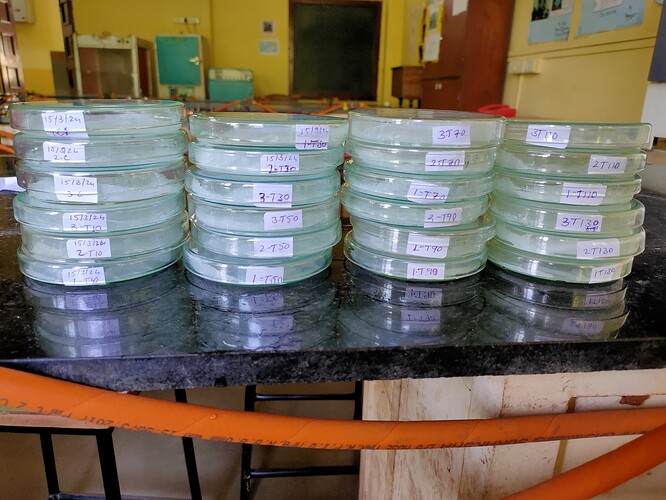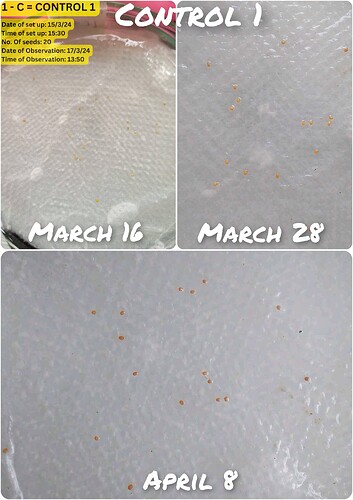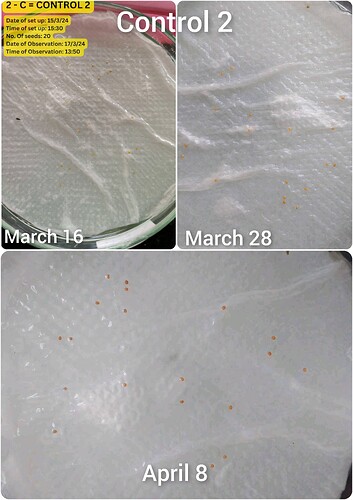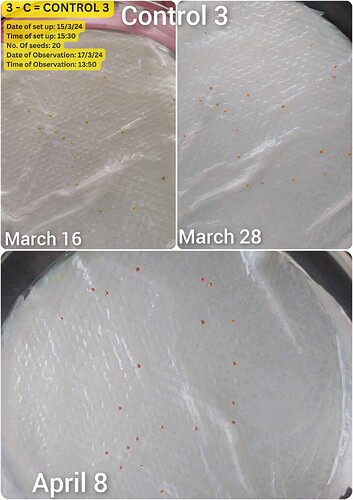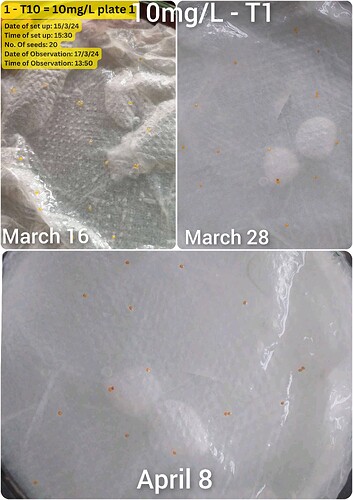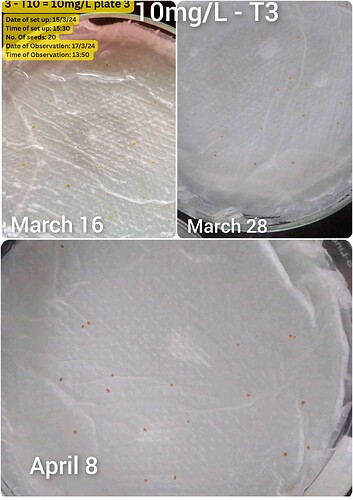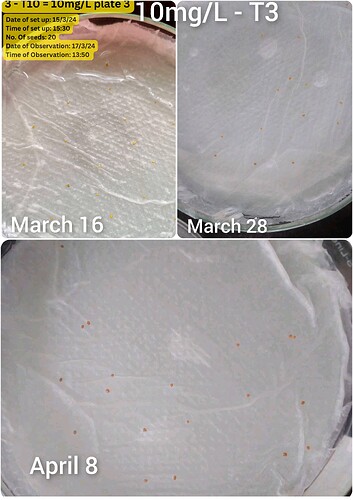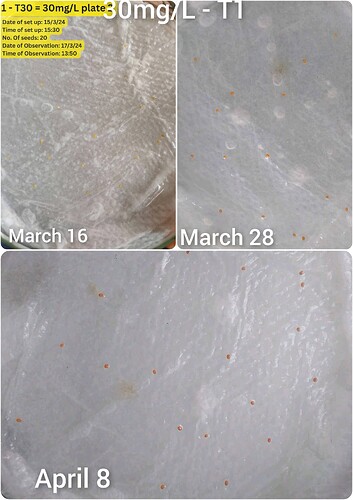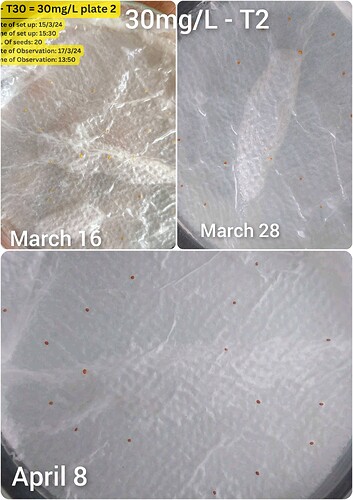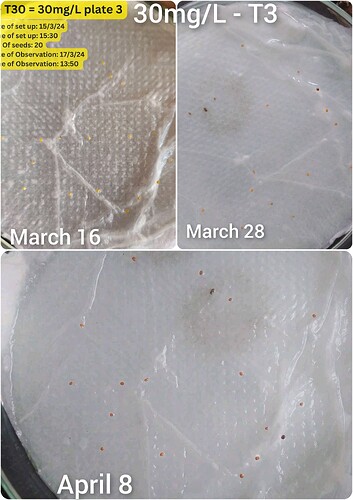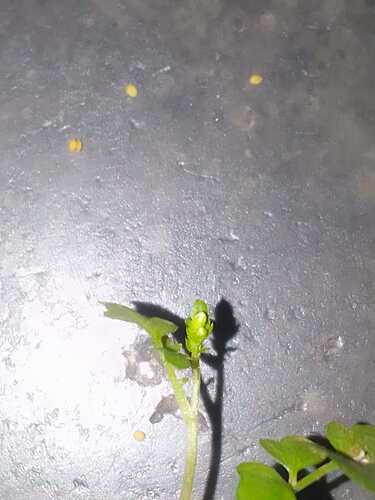Cardamine Seed Germination Studies
Aim: To find out the effect of different concentrations of kanamycin antibiotic on germination and growth of cardamine seeds.
Seeds collection: seeds were collected on 5th March 2024 by @Shraddha276 from panvel. She collected them from her CUBE Garden Lab
Date of set up: 15th March 2024
Experimental Design (Set up):
Control, 10, 30, 50, 70, 90, 110, and 130 mg/l of kanamycin. Each concentration with 20 seeds and 2 replicates.
- Control:
➔ C1
➔ C2
➔ C3 - 10 mg/L of kanamycin solution
➔ 10 mg/L - T1 (1T10)
➔ 10 mg/L - T2 (2T10)
➔ 10 mg/L - T3 (3T10) - 30 mg/L of kanamycin solution
➔ 30 mg/L - T1 (1T30)
➔ 30 mg/L - T2 (2T30)
➔ 30 mg/L - T3 (3T30) - 50 mg/L of kanamycin solution
➔ 50 mg/L - T1 (1T50)
➔ 50 mg/L - T2 (2T50)
➔ 50 mg/L - T3 (3T50) - 70 mg/L of kanamycin solution
➔ 70 mg/L - T1 (1T70)
➔ 70 mg/L - T2 (2T70)
➔ 70 mg/L - T3 (3T70) - 90 mg/L of kanamycin solution
➔ 90 mg/L - T1 (1T70)
➔ 90 mg/L - T2 (2T70)
➔ 90 mg/L - T3 (3T70) - 110 mg/L of kanamycin solution
➔ 110 mg/L - T1 (1T110)
➔ 110 mg/L - T2 (2T110)
➔ 110 mg/L - T3 (3T110) - 130 mg/L of kanamycin solution
➔ 130 mg/L - T1 (1T130)
➔ 130 mg/L - T2 (2T130)
➔ 130 mg/L - T3 (3T130)
Total 24 plates (8×3=24)
Date of set up: 15th March 2024
Expectation: seeds will germinate in 1 week with control showing maximum growth and growth would decrease with increase in concentration of kanamycin
Result: No germination was observed even after 24 days in any of the plates and seeds
Couldn’t share images further due to size (MB) of the image, so I’ve made a pdf and shared
In follow up thread I’ll add more pdf links of day wise observations
Interpretation: Reasons for not germinating would be
- Due to irregular watering pattern
- Adding extra water if absent for more than 2 days
- No oxygen as no air contact due to over watering
- Seeds become dormant in 10 days
- Seeds were not mature enough
- Due to microbial growth
- Because of 70% ethanol treatment given before set up to avoid microbial growth on seeds
Conclusion: As the germination did not take place. I kept 6 plates to observed further like how long it might take to germinate. Rest plates I took for next experiment.
6 plates I kept with me are
- Control - T1
- Control - T2
- 50 mg/L - T1
- 50 mg/L - T3 (as T2 had lot of microbial colonies)
- 90 mg/L - T1
- 90 mg/L - T2
New set up plan:
Aim: To find out the effect of different concentrations of Gentamicin antibiotic on germination and growth of cardamine seeds and perform floral dip method simultaneously.
Theory: The floral dip method is a simplified technique for transforming a plant using Agrobacterium tumefaciens. This involves dipping developing floral tissues into a solution containing Agrobacterium, sucrose, and a surfactant. The addition of sucrose and surfactant is crucial for successful transformation. As sucrose provides energy and osmotic balance while the surfactant aids in even spreading and penetration of Agrobacterium during the floral dip method for Arabidopsis thaliana transformation.
Advantages of Floral Dip Method:
- Simple and straightforward procedure.
- High success rate in generating transformed progeny.
- Results in genetically uniform plants with minimal variation.
- Saves time, labor, and expensive resources.
- Versatile for introducing specific genes or random mutagenesis.
Disadvantages of Floral Dip Method:
- Limited applicability to some plants
- Potential for unintended genetic effects.
- Reliance on Agrobacterium tumefaciens effectiveness.
- List item Challenges in stable gene integration and expression.
- Risk of contamination during the process.
Why are we choosing Gentamicin?
- Availability of agrobacterium: I was planning to perform a floral dip method by transferring kanamycin resistant gene but agrobacterium with kanamycin resistant gene was not available. I’ll be receiving agrobacterium with Gentamicin resistant gene on Wednesday from Dr Debabrata Laha’s Lab (IISc Bangalore) through @drishtantmkawale
- Similarly with kanamycin: They have agrobacterium tumefaciens with Gentamicin resistant gene and Rifampicin resistant gene. Gentamicin has the same mechanism of action as kanamycin. I’ll be using Gentamicin.
Plants and Seeds collection:
@Abhi0703 and I visited HBCSE on 10th April 2024 to collect cardamine plants and seeds. We selected a patch from where we collected seeds and took same plates for performing floral dip method.
Set up: i have 18 plates so I was planning to make 3 controls with no Gentamicin. 10, 30, 50, 70, 90mg/L with 3 plates each containing 20 seeds per plate.
Questions:
- Should I perform a cold treatment? If yes than for how many days?
- I have never discussed about Gentamicin so keeping these 5 concentrations would be enough? (One of the reference says 70mg/L Gentamicin was effective for arabidopsis thaliana)
Suggestion by Abhijeet:
Instead of making 3 plates, make 2 plates for each concentration and keep one in the fridge and the other outside.
What I think:
I should make 3 plates for each concentration and
- Keep 1 set in fridge for 1 day
- Keep other set in fridge for 3 days
- Keep 1 set without cold treatment…
Any more suggestions related to set up?

